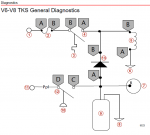saltshaker11
Cadet
- Joined
- Jun 14, 2017
- Messages
- 7
I have a 2008 Sea Ray Sport 205 with a Mercruiser 4.3L TKS engine. Recently the ignition fuse blew and I discovered that the TKS diode was shorted. After I removed the diode and replaced the fuse, the engine started and appeared to run fine. I ordered a new diode thinking that this would resolve the issue but when I put the new one in place, the ignition fuse blew again and the diode shorted out again. Again, when I removed the new diode and replaced the fuse, the engine started and ran fine.
I'm going to use the troubleshooting tips suggested in Mercruiser Service Manual #41 for TKS Carburetors and some of them call for running the engine during the testing. I'm wondering if that is risky at all ... is it harmful to run the engine without the TKS diode in place?
I'm guessing the problem is in one of the other parts of the TKS system, like the TKS Module or the Temperature switch. But I'd appreciate any suggestions that the experts on the forum might have because I'm kinda groping through this.
I also noticed that the oil pressure is reading higher than usual not sure if that is a coincidence or related to this.
Thanks!
I'm going to use the troubleshooting tips suggested in Mercruiser Service Manual #41 for TKS Carburetors and some of them call for running the engine during the testing. I'm wondering if that is risky at all ... is it harmful to run the engine without the TKS diode in place?
I'm guessing the problem is in one of the other parts of the TKS system, like the TKS Module or the Temperature switch. But I'd appreciate any suggestions that the experts on the forum might have because I'm kinda groping through this.
I also noticed that the oil pressure is reading higher than usual not sure if that is a coincidence or related to this.
Thanks!




















